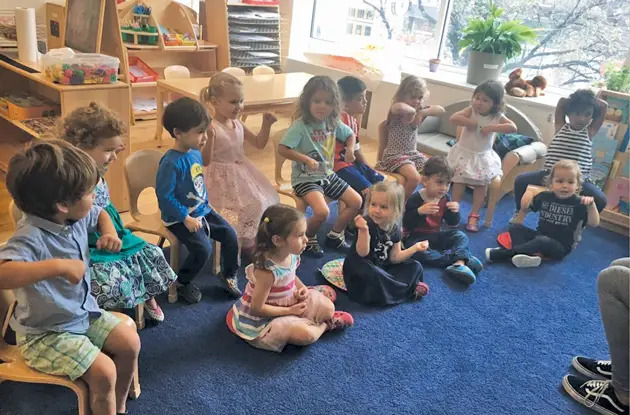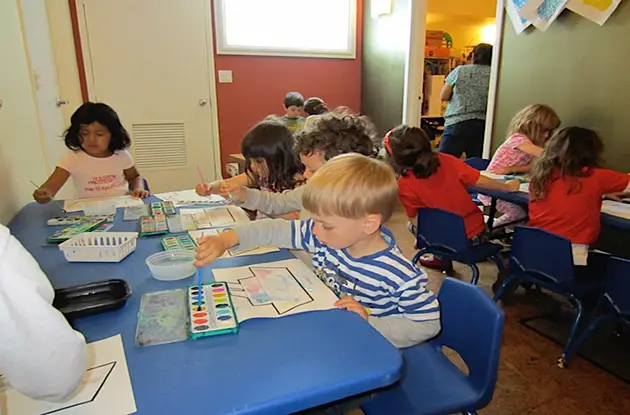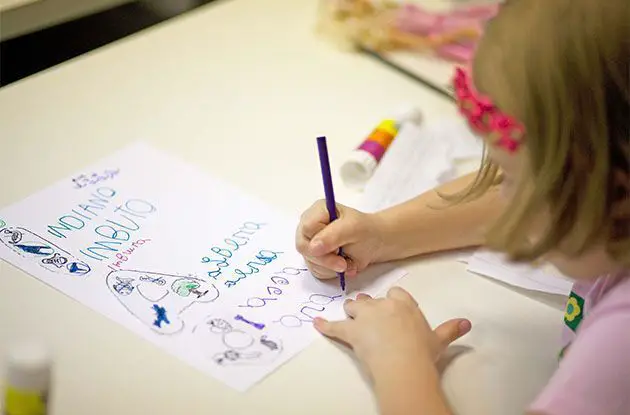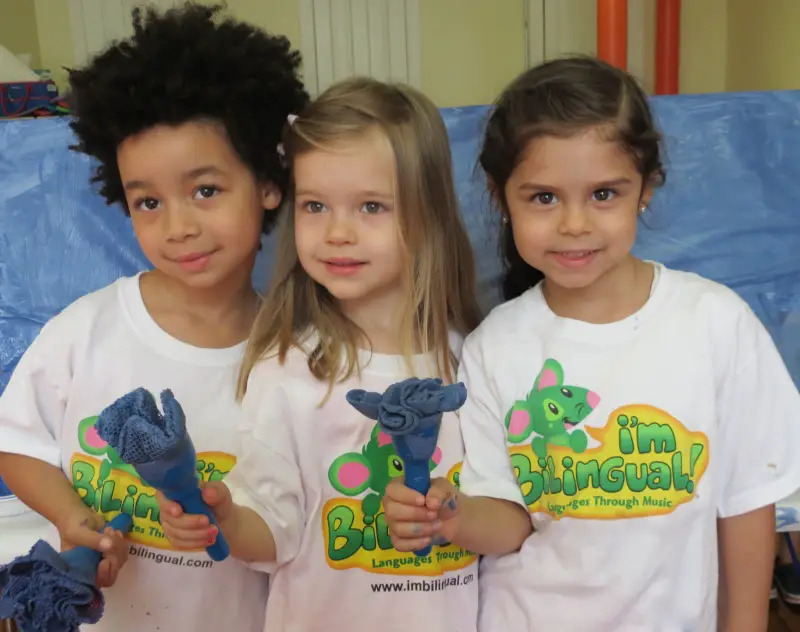Bonjour, ca va? Curious toddlers who step into West Park Presbyterian Church on Wednesday mornings are greeted with a singsong voice and smile from Michelle Bertrand, founder of Music & Play En Français. The foreign language playgroup — one of dozens held throughout the city — is part of a growing trend of parents opting to raise a bilingual child or give their babies a leg up by exposing them to a second language early on. Most are still in diapers, but folded in their moms’ laps for the next 45 minutes they’ll sing “If You’re Happy and You Know It” and “Old MacDonald Had a Farm”, listen to stories and play circle games — all in French. Some sit absolutely transfixed, others concentrate for a moment and wander off the way toddlers frequently do. Either way, parents bring their kids to the class in the hopes that their babies will gain some proficiency in French.
“This is one of her first playgroups,” says one of the moms, Regina who asked to be identified by her first name, in attendance with her 15-month-old daughter. “I’d like to have a little more exposure to another language and start her early. Hopefully, some of it will rub off.”
Alissa Owens and her husband, Mark, who live in Park Slope, have two children, Zoe, 9,and Jordan, 7. They hired Spanish babysitters who spoke to the children, from birth, only in Spanish “It was a major effort on our part,” Alissa says; the Owenses insisted the children speak Spanish to the babysitters and they created a library of Spanish books. Even more unusual, neither parent speaks Spanish. Both children attend Hannah Senesh, a Jewish day school in Cobble Hill where half the instruction is in Hebrew; both children are now tri-lingual.
The earlier the better
When it comes to learning a second language, the younger the better is what many linguists say. Research indicates there is a critical period for acquiring language that can begin as early as 7 months old. As children approach puberty, they lose this natural ability as the brain becomes less adept at creating the neural connections necessary for processing a new language. “There is a growing acceptance of the idea there is a window of opportunity or ‘critical period’ during which a person’s brain is unusually receptive to language learning,” writes Carey Miles in Raising Bilingual Children.
“The formative years are the first five years,” explains Bertrand, who was raised in a French-speaking household in New York, and didn’t speak English until she attended nursery school. “No one takes the class expecting to walk out and speak French fluently, but the more you expose children to different languages, the more you expose them to different sounds which opens up synapses in the brain.” This, according to Bertrand, creates a drawer for the language file in the brain, so when the child is older and exposed to language in a more formal setting, she’s not hearing a foreign language but another language that’s familiar.
Though many parents raise bilingual children for cultural reasons, studies available through the Center for Applied Linguistics suggest that there are other benefits children derive from being fluent in more than one language. On average, bilingual children read earlier than their monolingual peers, take a more creative approach to problem solving, and tend to score higher on standardized tests, even in areas non-related to language, such as math.
Another reason to expose children to a second language early on is the emotional advantages they enjoy. Francois Thibaut, founder of The Language Workshop for Children in Manhattan, notes that young children are rarely as self-conscious as adults and are not afraid of saying something wrong in another language. “Youngsters are willing to call out their new foreign words and their spontaneity pays off with a faster fluency adoption,” he says.
Though children raised in bilingual homes tend to speak later than monolingual children, it’s because the process of learning two native languages takes more time. Bertrand is doing what her parents did: speaking only French to her 4-year-old daughter at home and waiting until nursery school for her to learn English. “It’s amazing how fast she’s picking it up,” she says.
Consistency and commitment
Whether a parent is fluent in a second language, raising a bilingual child requires consistency and commitment. “It’s important to separate the languages that children are learning,” maintains Luisa Costa-Garro, a linguist and professor of education at Bank Street College. In families where the dad speaks English and the mom speaks another language, Costa-Garro says the optimum way to learn multiple languages is for the mother to consistently address the child in her native language and the father in his. Alejandra Novillo, who is raising her 6-year-old son and 8-month-old daughter bilingually, agrees. Married to a non-speaker of Spanish, Novillo only spoke Spanish at home with her son, Henry, who is now fluent in English and Spanish. Persistence is key, she says, noting that if Henry asked her a question in English, she wouldn’t answer until he repeated it in Spanish.
“The important thing is for children to be exposed to lots of language practice in the language of the home,” says Costa-Garro, who also advises families to find ways to incorporate the language they want their children to learn into fun and meaningful activities such as cooking, storytime and sing-alongs. Foreign language playgroups, videos, DVDs, music CDs and audiotapes available in the language of choice can also help. Costa-Garro, whose 19-year-old daughter is trilingual, says her family frequently had Spanish-speaking guests in their home and took numerous trips to Argentina, which increased her child’s exposure to the language, and also helped her acquire it in an authentic manner.
Though it certainly helps to have one fluent speaker in the household, babies are adept at learning languages, and fluency can be achieved by finding a babysitter who speaks a foreign language. “You have to be with friends who speak the language,” notes Novillo who began Juguemos A Cantar, a Spanish music and playgroup as a way of immersing her son in a Spanish-speaking environment. Now that Henry attends the local public school, Novillo reinforces the language of the home with Spanish magazines and videos, and has even found Yu-Gi-Oh, the popular trading card game, in Spanish.
Another option is a dual language school. Unlike bilingual programs, which are designed to teach English to non-English speakers, children enrolled in dual language immersion programs are expected to become fluent in two languages. Typically, half the students are native English speakers and half speak the designated language with instructional time divided, usually 50-50, between the two languages. New York City has several dual language schools, including P.S. 184, the Shuang Wen School in Chinatown, a PreK-6 school where students split their day between English and Mandarin Chinese, and the Amistad Dual Language School in Inwood, a K-8 school with a progressive philosophy where children graduate bilingual in English and Spanish.
Costa-Garro points out that as bilingual children grow older, they’re likely to stop speaking their home language. “Many may come back to it,” she says. “The language of the home is the language of roots, and many realize the importance of reconnecting with culture.”
Do You Speak ‘Parentese’?
Sure it feels silly, even condescending at times, but those exaggerated tones we use to talk to babies — “whoose a bee-yoo-tee-full baybee?” — are actually good for them. A study by Carnegie Mellon researchers published in Infancy found that babies learn to talk sooner when adults speak to them in “parentese”—the singsong, expressive use of language that seems to come naturally to so many adults when they encounter a baby.
In a series of experiments led by Dr. Erik Thiessen, director of Carnegie Mellon’s Infant Language and Learning Lab, 8-month-old infants were divided into two groups and exposed to fluent speech made up of nonsense words. One group heard the speech in parentese, or baby talk, and the other was exposed to the same speech in monotone. Researchers determined that the infants exposed to parentese learned to identify words more quickly than infants who heard the same communication in monotone. “Learning a language is one of the most critical things that an infant has to do, because communication with other people is so tremendously important,” says Dr. Thiessen. “It makes a great deal of sense that the special way we have of talking to babies would help them learn.”
The study also suggests that the simple sentences and slow word delivery people use with infants may be a factor in adopting a new language, a scenario not likely to happen with adults, which may also explain why grown-ups have a hard time learning a second language.
Oh Baby!
Product won’t do it alone, but exposing children to music, books and other resources is one way to stimulate and reinforce language learning. Here are some suggestions:
• Professor Toto’s Sing and Learn Start Kit is part of a series of multi-media language kits developed by New York’s Language Workshop for Children. Geared for ages 2 and up, the French starter kit brings the foreign language playgroup home, with music CDs, scripts, illustrated storybook of the songs, a fun activity book that helps build vocabulary, and other items. The kit can be purchased as a whole or a la carte. For further information, visit www.professortoto.com.
• Berlitz Publishing recently launched Baby Berlitz, a series of talking board books with titles such as Peek-A-Boo Family for ages 3 and under. The series is available in English and a bilingual English/Spanish and retails for $8.95. For older kids, Berlitz Kids 1000 Words is a useful reference published in Spanish and French. Detailed illustrations reminiscent of Richard Scarry’s Busy Busy Town are absorbing to look at but also contain everyday items labeled in English and French or Spanish. Geared to ages 8-11, the books retail for $9.95. For further information, visit www.berlitzbooks.com.
• How do you say wedgie power in Spanish? Captain Underpants, or Las adventuras del Capitán Calzoncillos (Scholastic, $4.99), the chapter book series by Dav Pilkey about a caped crusader who fights for truth, justice and all that is pre-shrunk and cottony, is also available in Spanish. Geared to readers 6-9, the Spanish versions contain the same illustrations, which make it fairly easy for non-speakers familiar with the series to follow along. There’s also the do-it-yourself Flip-O-Rama, which is still Flip-O-Rama in any language. Scholastic also publishes many of its other popular books series, such as Clifford the Big Red Dog, in Spanish. For further information, call 1-800-SCHOLASTIC or visit www.scholastic.com.





















